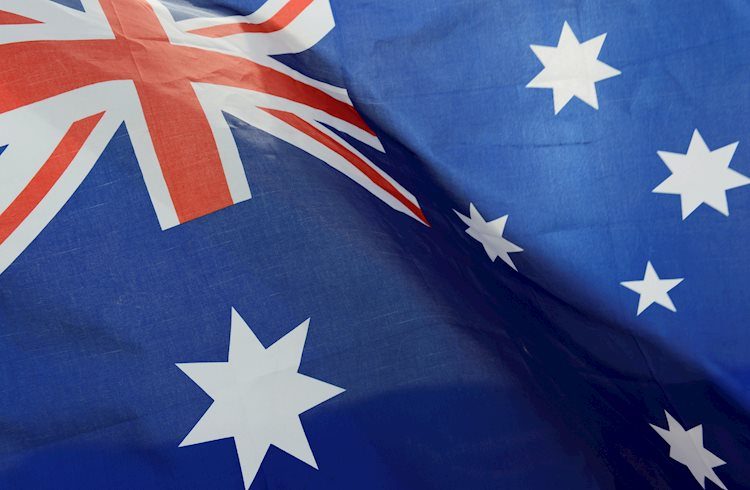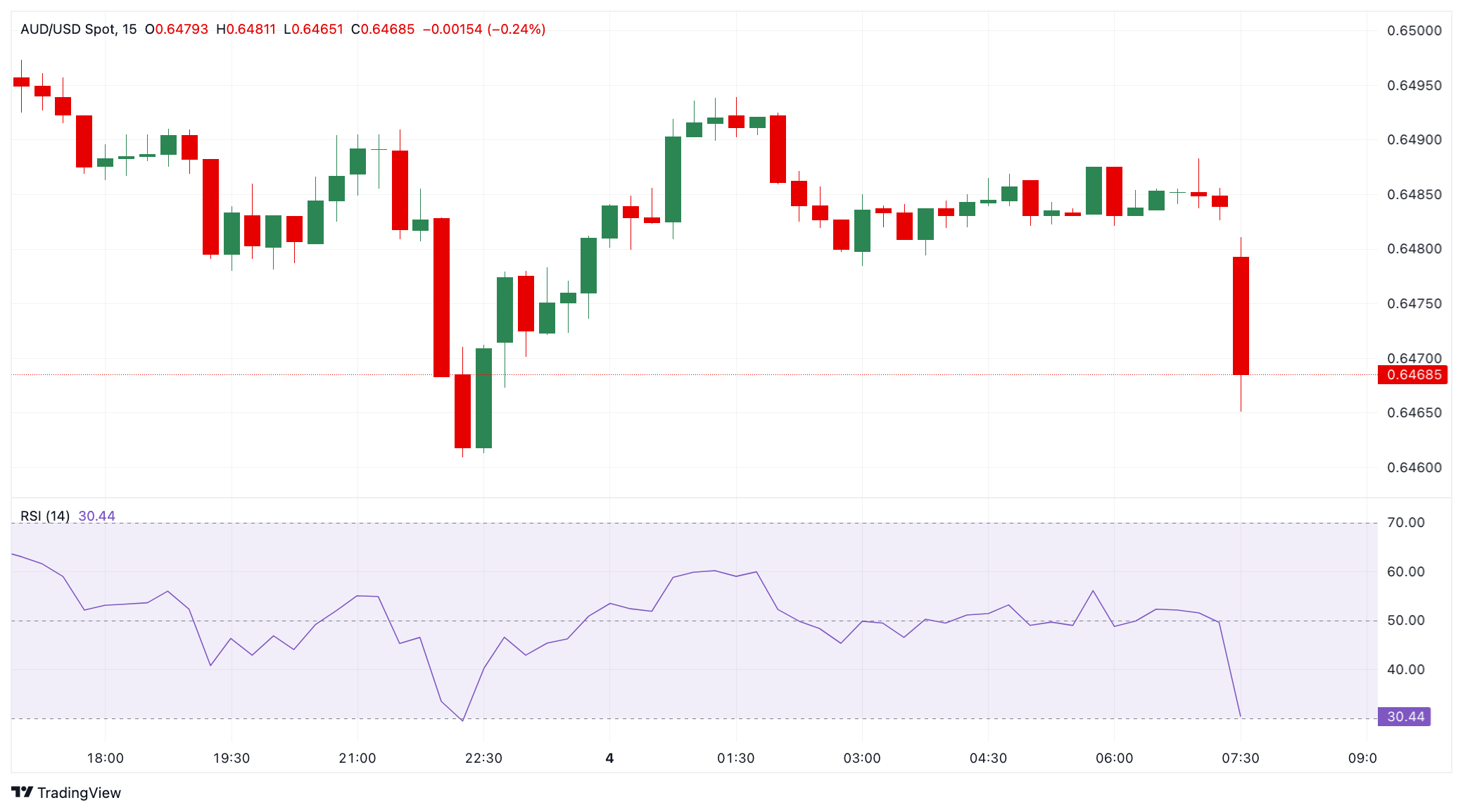Australia’s Gross Domestic Product (GDP) grew 0.3% QoQ in the third quarter (Q3) of 2024 compared with the 0.2% growth in the second quarter, the Australian Bureau of Statistics (ABS) showed on Wednesday. This reading came in below expectations of 0.4%.
The annual third-quarter GDP expanded by 0.8%, compared with the 1.0% growth in Q2 while below the consensus of a 1.1% increase.
Additional takeaways from the Australian GDP data
- Prior quarter 0.2%.
- GDP 0.3% versus 0.4% estimate.
- Real GDP YoY SA 0.8% versus 1.1% estimate. Prior quarter 1.0%.
- Final consumption 0.4%. Prior quarter 0.3%.
- Gross fixed capital expenditures 1.5%. Prior quarter -0.1%.
- GDP chain price index -0.2%. Prior quarter -0.9%.
Market reaction to Australia’s GDP data
The Australian Dollar attracts some sellers in an immediate reaction to the Australia GDP report. The AUD/USD pair is trading at 0.6469, losing 0.23% on the day.
AUD/USD 15-minute chart
Australian Dollar price in the last 7 days
The table below shows the percentage change of Australian Dollar (AUD) against listed major currencies in the last 7 days. Australian Dollar was the weakest against the Japanese Yen.
| USD | EUR | GBP | CAD | AUD | JPY | NZD | CHF | |
| USD | -0.08% | -0.73% | 0.16% | 0.15% | -2.19% | -0.62% | 0.08% | |
| EUR | 0.08% | -0.66% | 0.23% | 0.23% | -2.11% | -0.57% | 0.16% | |
| GBP | 0.73% | 0.65% | 0.89% | 0.88% | -1.45% | 0.10% | 0.81% | |
| CAD | -0.16% | -0.23% | -0.89% | -0.04% | -2.35% | -0.78% | -0.08% | |
| AUD | -0.15% | -0.22% | -0.89% | 0.01% | -2.34% | -0.78% | -0.06% | |
| JPY | 2.14% | 2.04% | 1.42% | 2.30% | 2.26% | 1.51% | 2.22% | |
| NZD | 0.62% | 0.55% | -0.11% | 0.78% | 0.77% | -1.56% | 0.71% | |
| CHF | -0.08% | -0.16% | -0.82% | 0.08% | 0.05% | -2.28% | -0.71% |
The heat map shows percentage changes of major currencies against each other. The base currency is picked from the left column, while the quote currency is picked from the top row. For example, if you pick the Euro from the left column and move along the horizontal line to the Japanese Yen, the percentage change displayed in the box will represent EUR (base)/JPY (quote).
This section below was published at 21.45 GMT on Wednesday as a preview of the Australia’s Gross Domestic Product report
- Australian Gross Domestic Product is foreseen to be up by 1.1% in Q3 compared with the same quarter a year earlier.
- The Reserve Bank of Australia will likely maintain the OCR on hold until later in 2025.
- The Australian Dollar advances against its United States rival, sellers waiting for better levels.
Australia will release Gross Domestic Product (GDP) figures for the third quarter (Q3) on Wednesday. The Australian Bureau of Statistics (ABS) is expected to report that the economy grew 0.4% compared with the previous quarter and 1.1% when compared with Q3 2023r. Annual growth in the second quarter printed at 1%, the slowest pace of growth since the coronavirus-led recession in 2020. The anticipated 1.1% barely surpasses such a mark, and will continue to indicate that the Australian economy has not yet turned the corner.
What to expect from the Q3 GDP report
The Australian economy is expected to have grown by 1.1% annually. GDP figures are among those that have a large impact on the local currency, in this case, the Australian Dollar (AUD).
Meanwhile, the Reserve Bank of Australia (RBA) keeps interest rates unchanged. The Official Cash Rate (OCR) was lifted for the last time in November 2023 and currently stands at 4.35%, and the RBA Board has maintained it there for over a year now amid stubbornly high inflation.
Higher interest rates have finally done the job. According to the latest data from the Australian Bureau of Statistics (ABS), the October monthly Consumer Price Index calculated year-over-year (YoY) printed at 2.1% for a second consecutive month. It is worth remembering that the RBA’s goal is to keep inflation between 2% and 3% YoY.
Even further, the quarterly CPI rose 0.2% in the three months to September and by 2.8% compared to the same quarter of 2023, its lowest increase in over three years and falling back into the RBA’s target band. The Q3 RBA Trimmed Mean CPI, the RBA’s favorite inflation gauge, was up 0.8% in the quarter and by 3.5% from a year earlier, easing from the previous 4% but still a tad higher than the RBA’s goal.
On the contrary, higher interest rates also mean slower economic progress amid higher financial costs. Lowering the OCR would spook the ghost of recession, yet probably revive inflationary pressures. However, boosting the economy is not within the RBA’s mandate.
Theoretically, growth-related figures should not affect policymakers’ decisions. Nevertheless, they do. RBA officials will not acknowledge concerns on the matter but rather maintain the focus on inflation.
The RBA will hold the last monetary policy meeting of the year next week but will likely maintain the OCR unchanged. The most optimistic outlook is that the first interest rate cut will come in February 2025, although there is increased speculation that the RBA won’t act until later in the year, probably around May.
How can the GDP report affect the Australian Dollar?
The GDP report will be released on Wednesday at 00:30 GMT, and market participants will consider the impact of the figures on upcoming RBA decisions. Upbeat growth-related figures could have a positive impact on the AUD while providing policymakers with the relief they need to keep rates at record levels.
However, lower-than-expected figures would mean the risk of a recession is becoming more real. The AUD may take the hit as policymakers could be forced to acknowledge a rate cut is necessary to prevent a steep economic setback.
Valeria Bednarik, Chief Analyst at FXStreet, notes: “The AUD/USD pair trades near the lower end of its November range amid broad US Dollar’s (USD) strength. The ongoing near-term recovery amid a better market mood is not enough to put the pair on a bullish track. Technical indicators in the daily chart remain within negative levels, offering modest upward slopes that suggest mounting USD selling rather than AUD buying. Even further, a firmly bearish 20 Simple Moving Average (SMA) provides dynamic resistance since mid-November, currently standing at 0.6514.”
Bednarik adds: “Better-than-anticipated GDP readings could push the pair beyond the mentioned resistance level and send AUD/USD towards 0.6570, a static resistance area. Nevertheless, the pair may resume its slide once the dust settles. Persistent risk appetite, however, may keep it afloat. The November monthly low at 0.6433 provides immediate support en route to the 0.6350 price zone, where AUD/USD bottomed in August.”
Australian Dollar FAQs
One of the most significant factors for the Australian Dollar (AUD) is the level of interest rates set by the Reserve Bank of Australia (RBA). Because Australia is a resource-rich country another key driver is the price of its biggest export, Iron Ore. The health of the Chinese economy, its largest trading partner, is a factor, as well as inflation in Australia, its growth rate and Trade Balance. Market sentiment – whether investors are taking on more risky assets (risk-on) or seeking safe-havens (risk-off) – is also a factor, with risk-on positive for AUD.
The Reserve Bank of Australia (RBA) influences the Australian Dollar (AUD) by setting the level of interest rates that Australian banks can lend to each other. This influences the level of interest rates in the economy as a whole. The main goal of the RBA is to maintain a stable inflation rate of 2-3% by adjusting interest rates up or down. Relatively high interest rates compared to other major central banks support the AUD, and the opposite for relatively low. The RBA can also use quantitative easing and tightening to influence credit conditions, with the former AUD-negative and the latter AUD-positive.
China is Australia’s largest trading partner so the health of the Chinese economy is a major influence on the value of the Australian Dollar (AUD). When the Chinese economy is doing well it purchases more raw materials, goods and services from Australia, lifting demand for the AUD, and pushing up its value. The opposite is the case when the Chinese economy is not growing as fast as expected. Positive or negative surprises in Chinese growth data, therefore, often have a direct impact on the Australian Dollar and its pairs.
Iron Ore is Australia’s largest export, accounting for $118 billion a year according to data from 2021, with China as its primary destination. The price of Iron Ore, therefore, can be a driver of the Australian Dollar. Generally, if the price of Iron Ore rises, AUD also goes up, as aggregate demand for the currency increases. The opposite is the case if the price of Iron Ore falls. Higher Iron Ore prices also tend to result in a greater likelihood of a positive Trade Balance for Australia, which is also positive of the AUD.
The Trade Balance, which is the difference between what a country earns from its exports versus what it pays for its imports, is another factor that can influence the value of the Australian Dollar. If Australia produces highly sought after exports, then its currency will gain in value purely from the surplus demand created from foreign buyers seeking to purchase its exports versus what it spends to purchase imports. Therefore, a positive net Trade Balance strengthens the AUD, with the opposite effect if the Trade Balance is negative.Economic Indicator
Gross Domestic Product (QoQ)
The Gross Domestic Product (GDP), released by the Australian Bureau of Statistics on a quarterly basis, is a measure of the total value of all goods and services produced in Australia during a given period. The GDP is considered as the main measure of Australian economic activity. The QoQ reading compares economic activity in the reference quarter to the previous quarter. Generally, a rise in this indicator is bullish for the Australian Dollar (AUD), while a low reading is seen as bearish.
The Trade Balance, which is the difference between what a country earns from its exports versus what it pays for its imports, is another factor that can influence thevalue of the Australian Dollar. If Australia produces highly sought after exports, then its currency will gain in value purely from the surplus demand created from foreign buyers seeking to purchase its exports versus what it spends to purchase imports. Therefore, a positive net Trade Balance strengthens the AUD, with the opposite effect if the Trade Balance is negative.When an economy grows and GDP is rising, people tend to spend more which leads to inflation. The country’s central bank then has to put up interest rates to combat the inflaion. Higher interest rates are negative for Gold because they increase the opportunity-cost of holding Gold versus placing the money in a cash deposit account. Therefore, a higher GDP growth rate is usually a bearish factor for Gold price

